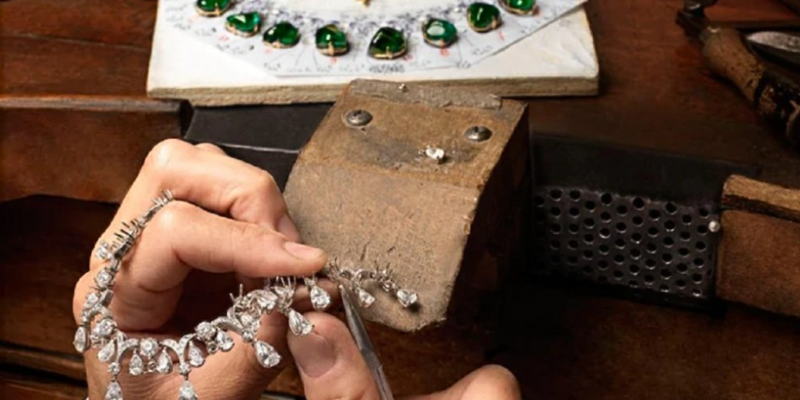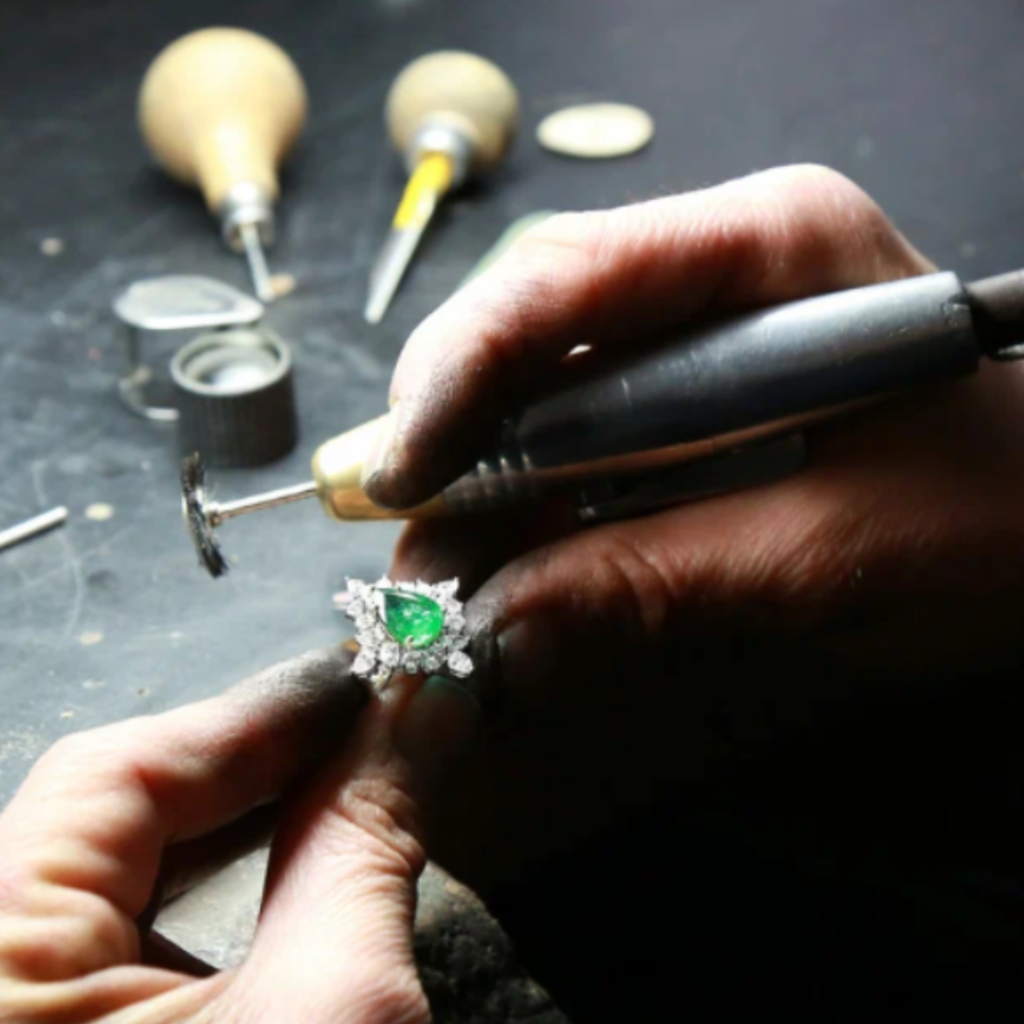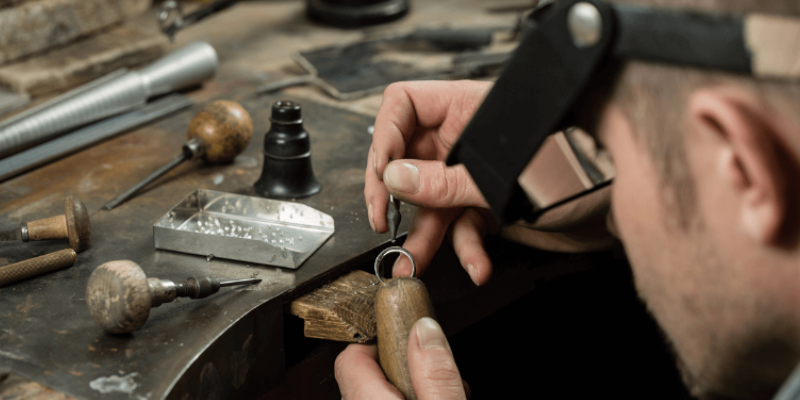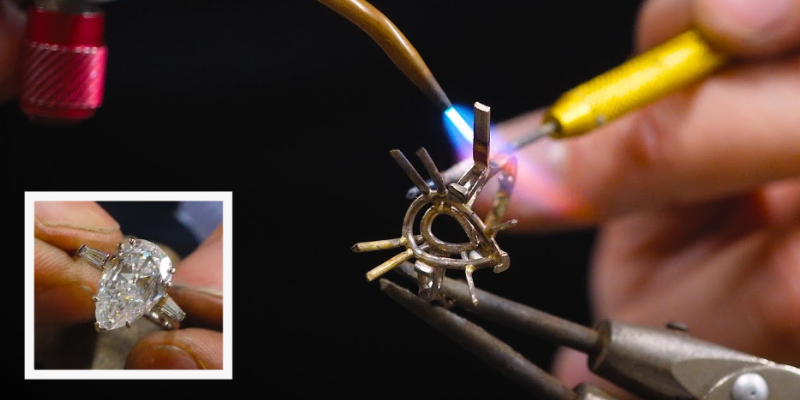
Jewellery holds a special place in our lives, often carrying sentimental value, cherished memories, and a timeless beauty. However, even the finest pieces are subject to damage or shine loss due to the unavoidable effects of time and wear and tear. In order to preserve the history of precious heirlooms for future generations, the skill of jewellery restoration is essential.
The technique of restoring jewellery involves cleaning, repairing, and refinishing priceless items that have been worn out, damaged, or require redesign. Restoration may bring back to life any item, be it a treasured family heirloom, an antique, or a modern piece that has seen better days.
Restoration may be necessary due to various reasons, such as:
- Damage: Broken prongs, missing stones, bent or broken metal components.
- Wear and Tear: Thinning of metal, scratches, dullness, or discoloration.
- Redesigning: Updating an outdated style or repurposing old jewellery into a new design.
Virtually any type of jewellery, from rings and necklaces to bracelets and earrings, can benefit from restoration, provided the piece holds sentimental or monetary value.
The Art and Process of Jewellery Restoration
Jewellery restoration is an art form that involves artistic talent, technical skills, and careful attention to detail. It requires an in-depth knowledge of gemology, metalsmithing, and the background of various jewellery styles and eras.
Successful restoration demands a wide range of skills, including:
- Attention to Detail: Restorers must have a keen eye for identifying even the slightest imperfections or damage.
- Artistic Ability: Recreating intricate designs, matching colours, and maintaining the aesthetic appeal of a piece requires a strong artistic sensibility.
- Technical Knowledge: Mastery of metalworking techniques, gemstone setting, and the properties of various materials is essential.
Depending on the piece’s state and the desired result, several procedures may be used throughout the restoration process. Typical methods include the following:
- Cleaning and Polishing: Removing tarnish, dirt, and oxidation to restore the jewellery’s original lustre and shine. This process often involves the use of specialized solutions, ultrasonic cleaners, and polishing machines to gently yet effectively remove build-up and restore the piece’s brilliance. Proper cleaning is crucial to prepare the surface for any necessary repairs or enhancements.
- Stone Resetting: Securely resetting loose or missing gemstones, ensuring they are properly aligned and secured. This delicate process involves carefully removing the existing stones, inspecting and repairing the settings if needed, and precisely positioning the stones back in place. Restorers use specialized tools and techniques to ensure a secure and long-lasting fit, while also maintaining the aesthetic integrity of the design.
- Metal Repair: Fixing broken or bent metal components, such as prongs, shanks, or clasps. This may involve techniques like soldering, welding, or metal casting to rebuild or replace damaged sections. Skilled restorers must have a deep understanding of metalsmithing and the properties of various metals to ensure a seamless and structurally sound repair.
- Engraving and Embellishment: Recreating intricate engravings, filigree work, or other decorative elements. This requires a high level of artistic skill and precision, as the restorer must carefully study and replicate the original designs. Specialized engraving tools and techniques are used to capture the intricate details and maintain the historical accuracy of the piece.
- Resizing and Reshaping: Adjusting the size of rings or reshaping metal components to suit the wearer’s preferences. This process involves carefully heating and manipulating the metal to achieve the desired size or shape, while also ensuring the structural integrity of the piece is maintained. Restorers must have a deep understanding of metal properties and techniques to prevent distortion or damage during this process.
Skilled jewellers and restorers often work with a variety of specialised tools and materials, including:
- Jeweller’s loupes and microscopes for close inspection
- Engraving tools and gravers for intricate metalwork
- Soldering equipment for joining metal components
- Polishing machines and compounds for achieving a high shine
- Gemstone setting tools and supplies
Throughout the restoration process, professional jewellers rely on their expertise and knowledge to preserve the integrity and character of each piece while bringing it back to its former glory.

Evaluating the Condition of Your Jewellery
Before embarking on the restoration journey, it is crucial to evaluate the condition of your jewellery piece. This assessment will guide the approach and inform the restorer about the extent of work required.
Here are some key steps to evaluate your jewellery’s condition:
- Visual Inspection: Carefully examine the piece under good lighting, looking for signs of wear, damage, or missing parts. Check for loose stones, bent prongs, cracks, or discoloration.
- Determine Value and Sentimental Importance: Assess the monetary value, historical significance, and personal sentimental value of the piece. This will help weigh the cost and effort of restoration against its value.
- Consider Age and Rarity: Antique or rare jewellery may require specialised techniques and materials to preserve its authenticity and historical integrity. Seek guidance from experts in these cases.
- Consult Professional Jewellers: Experienced jewellers and restorers can provide a comprehensive evaluation, identifying issues that may not be immediately apparent and offering expert advice on the feasibility and approach to restoration.
During this evaluation phase, it is essential to document the piece’s current condition through detailed photographs and notes. These records will serve as a reference point for the restoration process and help track the progress.
The Jewellery Restoration Process Step-by-Step
After the assessment is over and it is decided to restore the piece, the restoration process can start. Here is a general overview of the steps that are involved:
- Initial Evaluation and Documentation: The restorer will thoroughly inspect the piece, documenting its condition through photographs, notes, and detailed sketches. This serves as a reference point for the restoration process.
- Disassembly and Cleaning: If necessary, the piece will be carefully disassembled, with each component meticulously cleaned and prepared for repair or replacement.
- Repair or Replacement of Damaged Parts: Broken or worn components, such as prongs, shanks, or clasps, will be repaired or replaced using techniques like soldering, metalsmithing, or casting.
- Stone Resetting: Loose or missing gemstones will be securely reset, ensuring proper alignment and security. This may involve creating new settings or modifying existing ones.
- Polishing and Refinishing: The item will go through a polishing and refinishing procedure to bring back its original sheen and brightness after the repairs are finished. Several methods, including buffing, oxidising, and plating, might be used for this.
- Final Touches and Quality Control: The restorer will add any final touches, such as engraving or embellishments, before conducting a thorough quality control inspection to ensure the piece meets the highest standards.
Throughout the restoration process, meticulous documentation and communication with the client are essential to ensure the final result matches their expectations and preserves the piece’s integrity.

Maintaining Restored Jewellery
After investing time and resources into restoring a precious piece of jewellery, it is essential to take proper care to ensure its longevity and maintain its restored beauty. Here are some tips for maintaining restored jewellery:
- Proper Handling and Storage: Handle restored pieces with care, avoiding exposure to harsh chemicals, extreme temperatures, or rough surfaces. Store them in a soft, lined jewellery box or pouch, away from direct sunlight and moisture.
- Regular Cleaning: Follow the restorer’s recommendations for gentle cleaning and polishing. Avoid using harsh chemicals or abrasives, as they can damage the restored surfaces.
- Professional Maintenance: Seek professional cleaning and maintenance services from a reputable jeweller on a regular basis. They can inspect the piece, ensure the integrity of stone settings, and address any emerging issues.
- Insurance: Valuable restored pieces should be adequately insured against loss, theft, or damage. Keep detailed records, including photographs and appraisals, for insurance purposes.
By following these maintenance guidelines, you can ensure that the time, effort, and resources invested in restoring your cherished jewellery pieces are protected, allowing you to enjoy their beauty for years to come.
Costs and Considerations for Jewellery Restoration
The cost of jewellery restoration can vary significantly depending on several factors, including:
- Labour: The skill and experience of the restorer, as well as the complexity and time required for the restoration, will impact the labour costs.
- Materials: The type and quality of materials needed for repairs or replacements, such as precious metals, gemstones, or specialty components, can add to the overall cost.
- Complexity: More intricate designs, extensive damage, or rare or antique pieces may require specialised techniques and materials, increasing the restoration costs.
- Rarity and Value: The rarity and monetary value of the piece can also influence the restoration costs, as greater care and attention may be required.
It is essential to obtain detailed estimates from reputable and qualified restorers before proceeding with the restoration process. These estimates should itemise the costs for labour, materials, and any additional services required.
It’s important to evaluate the piece’s monetary and sentimental worth in addition to the expenses. The expense of restoring a piece may occasionally be higher than its replacement value, but the sentimental value can make the expenditure justified. However, it could be more sensible to think about replacing the piece entirely if the repair expenses are unreasonably expensive.
| Restoration Cost Factor | Potential Impact |
| Extensive Damage | Higher labour costs, more materials required |
| Rare or Antique Piece | Specialised techniques, harder to source materials |
| Intricate Design | More labour-intensive, higher skill level required |
| Precious Metals/Gemstones | Higher material costs for replacement components |
Working with reputable and qualified jewellery restorers is paramount. Look for individuals or companies with a proven track record, positive reviews, and proper credentials. They should be transparent about their processes, costs, and timelines, and be willing to communicate openly throughout the restoration journey.
By understanding the potential costs and considerations involved in jewellery restoration, you can make an informed decision about whether to proceed with the process or explore alternative options for your cherished piece.

The Emotional Value of Jewellery Restoration
While the technical aspects of jewellery restoration are undoubtedly crucial, the emotional value behind preserving cherished pieces cannot be understated. For many individuals, jewellery holds far more than monetary worth; it represents a connection to their personal history, cherished memories, and family legacies.
Preserving Family Heirlooms and Sentimental Pieces Heirloom jewellery, passed down through generations, carries a profound sentimental significance. These pieces serve as tangible links to our ancestors, their stories, and the traditions they upheld. Restoring a beloved family heirloom not only preserves its physical beauty but also honours the emotional bonds it represents.
Restoring Antique and Vintage Jewellery Antique and vintage jewellery pieces are not mere accessories; they are windows into the past, offering glimpses into the craftsmanship, styles, and cultural influences of bygone eras. Restoring these pieces is akin to preserving history itself, allowing us to appreciate the artistry and skill of generations past.
The Art of Jewellery Restoration as a Craft Beyond the sentimental aspects, jewellery restoration is an art form in its own right. Skilled restorers possess a deep appreciation for the craftsmanship that went into creating each piece. Their work not only revives the physical beauty of jewellery but also pays homage to the artisans who originally crafted these intricate designs.
“Jewellery restoration is not just a technical process; it’s a labour of love. Each piece carries a story, and it’s our responsibility to ensure that story lives on.” – James Marsh, Master Jeweller, The Jewellery Mechanic
By restoring cherished jewellery pieces, we preserve not only their physical beauty but also the memories, traditions, and emotional connections they represent. It is a way to honour our personal histories while appreciating the timeless artistry of jewellery making.
Finding a Qualified Jewellery Restorer
Entrusting your precious jewellery to a skilled restorer is a crucial step in the restoration process. Here are some tips to help you find a qualified and reputable professional:
- Research and Verify Credentials: Look for restorers who have formal training, certification, or accreditation from respected jewellery organisations. Check their credentials and experience in the field.
- Ask for Portfolios and References: Request to see portfolios of their previous restoration work. This will give you a sense of their skill level and attention to detail. Additionally, ask for references from satisfied clients.
- Get Detailed Estimates and Timeframes: Reputable restorers should provide detailed estimates outlining the scope of work, materials required, and associated costs. They should also provide realistic timeframes for completing the restoration process.
- Communicate Your Vision: Clearly communicate your expectations and vision for the restored piece. Share any sentimental or historical significance, as well as any design preferences or modifications you have in mind.
- Visit Their Studio or Workshop: If possible, visit the restorer’s studio or workshop. This will give you insight into their working environment, tools, and professionalism.
- Consider Specialisations: Some restorers may specialise in specific areas, such as antique jewellery, gemstone setting, or particular metalworking techniques. Choose a restorer whose expertise aligns with your piece’s needs.
- Trust Your Instincts: While credentials and portfolios are important, also trust your instincts. A good restorer should be knowledgeable, transparent, and make you feel confident in their abilities.
Remember, finding the right jewellery restorer is an investment in preserving the beauty, craftsmanship, and emotional value of your treasured pieces. Take the time to research and choose a professional you can trust.
Conclusion
The art of jewellery restoration is a delicate balance of technical skill, artistic vision, and emotional appreciation. Whether you seek to restore a cherished family heirloom, an antique find, or a contemporary piece in need of repair, the journey of restoration is one that breathes new life into these precious objects.
Throughout this guide, we’ve explored the intricate world of jewellery restoration, from evaluating the condition of your pieces to understanding the step-by-step restoration process. We’ve delved into the importance of proper maintenance and the emotional significance behind preserving these tangible connections to our personal histories.
As you embark on your own restoration journey, remember the profound impact it can have. By entrusting your treasured pieces to skilled restorers, you not only preserve their physical beauty but also honour the stories, traditions, and craftsmanship they represent.
So, if you have a cherished piece of jewellery in need of restoration, take the first step. Seek out a qualified and reputable restorer, such as the experts at The Jewellery Mechanic, a brand renowned for their expertise in jewellery cleaning & restoration services. With their meticulous attention to detail and deep appreciation for the art of jewellery making, they can breathe new life into your precious pieces.
Embrace the art of jewellery restoration, and let your treasured pieces continue to shine, carrying their stories and your memories into the future.
